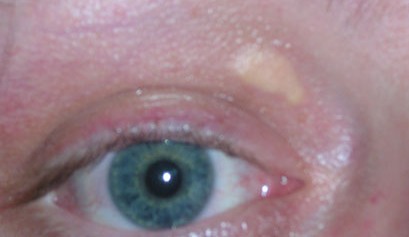Hyperlipoproteinemia physical examination
|
Lipoprotein Disorders Microchapters |
Editor-In-Chief: C. Michael Gibson, M.S., M.D. [1]
Overview
Physical Examination
Due to deposition of cholesterol in the skin and the tendons, patients with familial hypercholesterolemia or familial defective apoB-100 may have several types of xanthomas, which include:
- Planar xanthomas (on hands, elbows, buttocks, or knees), which are diagnostic for the homozygous familial hypercholesterolemia and are distinct from other cutaneous xanthomas because of their yellow-to-orange coloration.
- Tuberous xanthomas (on hands, elbows, or knees)
- Tendon xanthomas (on extensor tendons of hands or Achilles tendon), which can be detected by careful palpation rather than simple inspection, which reveals diffusely thickened tendon or discreet irregularities along the tendon.
Patients with homozygous familial hypercholesterolemia may have cutaneous xanthomas at birth or by early childhood and other types of xanthomas are usually obvious in the first decade of life, whereas patients with heterozygous familial hypercholesterolemia may develop xanthomas in the third decade of life and later.
- Xanthelasma, may occur in older patients with normal cholesterol levels

- Corneal arcus, due to deposition in the cornea which may also be occasionally present in older adults with normal cholesterol levels

Copyleft image obtained courtesy of http://en.wikipedia.org/wiki/File:Four_representative_slides_of_corneal_arcus.jpg#file; Loren A Zech Jr and Jeffery M Hoeg.
Copyleft image obtained courtesy of http://en.wikipedia.org/wiki/File:Four_representative_slides_of_corneal_arcus.jpg#file; Loren A Zech Jr and Jeffery M Hoeg.
